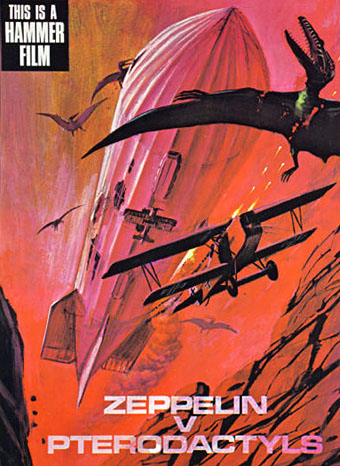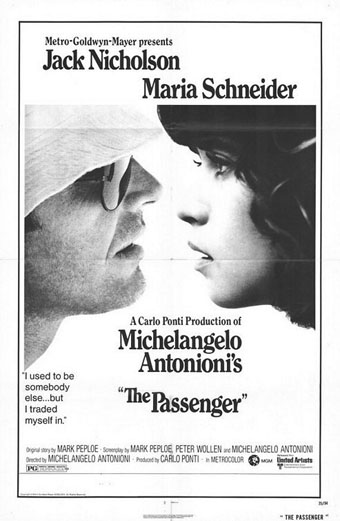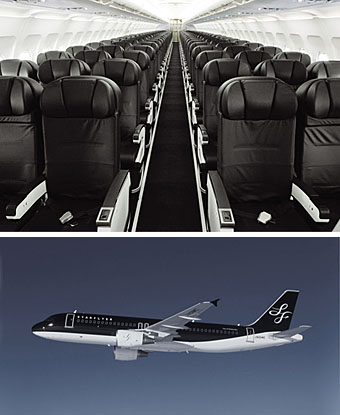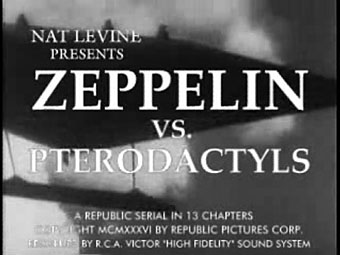Classic British cinema isn’t worthy of the name
Because it’s dull, reactionary and sexless; John Patterson plays my tune.
Month: August 2007
Black is the new black
This is what we want—an airline that matches my monochrome wardrobe. Star Flyer is Japanese, unfortunately, and I’m guessing that black doesn’t have the same funereal associations in Japan; that livery wouldn’t, er “fly” here. Makes a change from the sky blue monotony that’s the usual colour scheme in aircraft, anyway. PingMag looks at the resurgence of interest in black as a Japanese design choice, from toilet paper to cotton swabs, toothpaste and even black eggs. If you were eating the latter you’d have to be listening to the Nightcrawlers at the same time. And drinking black coffee. But I’d advise that you avoid black pudding; that stuff is just nasty.
Paradise Now: The Living Theatre in Amerika DVD
 Most people today know Julian Beck, if at all, for a small but unforgettable film role at the end of his career. In Poltergeist 2 (1986) Beck plays the nightmarishly sinister Reverend Henry Kane and his one full scene in that film is far more unnerving than the rest of its rubber monsters and special effects. Beck, a bisexual radical who makes most contemporary theatre directors seem as challenging as civil servants, started out as a painter but moved into theatre in the late Forties, founding the legendary Artaud-inspired Living Theatre in 1947. The Living Theatre was to the stage what the Beats were to literature, intent on shaking up the medium, the audience’s complacency and—by implication—society itself, to the fullest extent possible.
Most people today know Julian Beck, if at all, for a small but unforgettable film role at the end of his career. In Poltergeist 2 (1986) Beck plays the nightmarishly sinister Reverend Henry Kane and his one full scene in that film is far more unnerving than the rest of its rubber monsters and special effects. Beck, a bisexual radical who makes most contemporary theatre directors seem as challenging as civil servants, started out as a painter but moved into theatre in the late Forties, founding the legendary Artaud-inspired Living Theatre in 1947. The Living Theatre was to the stage what the Beats were to literature, intent on shaking up the medium, the audience’s complacency and—by implication—society itself, to the fullest extent possible.
It’s the tragedy of theatre that its nature as a medium dependent on performance leaves so little record of its works behind. But there is one major film of the Living Theatre at its most provocative and it’s fitting that this should appear on a new DVD from Arthur Magazine in the year of the company’s sixtieth anniversary.
NEW FROM ARTHUR: PARADISE NOW: THE LIVING THEATRE IN AMERIKA DVD. LIMITED EDITION OF 1,000 – PRE-ORDER NOW – SHIPS OCT 1ST, 2007!
the screams
the unchained soarings of a sincerity which is on its way
to this revolution of the whole body without which nothing can
be changed. – Antonin Artaud
Arthur Magazine proudly presents our newest release PARADISE NOW: The Living Theatre in Amerika DVD featuring rare, never-before-distributed films and a bacchanal of revolutionary multimedia documents from The Living Theatre’s historic and influential ’68–’69 American tour. A fulminating art-meets-life installation brought to you in collaboration with The Living Theatre, The Ira Cohen Akashic Project and Saturnalia Media Rites of the Dreamweapon.
DVD INCLUDES – PARADISE NOW: The Living Theatre in Amerika (1969) a film by Marty Topp, produced by Ira Cohen for Universal Mutant
• EMERGENCY (1968) a film by Gwen Brown, featuring precious footage of Living Theatre productions Mysteries and smaller pieces, Paradise Now, and Frankenstein
• RARE PHOTOGRAPHS of Paradise Now at Brooklyn Academy of Music by Don Snyder
• THE MAP OF PARADISE NOW, a 14″ x 19″ double-sided, commemorative poster + ‘zine including texts by Antonin Artaud, Julian Beck, Judith Malina, Ira Cohen and Don Snyder
ADDITIONAL SPECIAL FEATURES
• Slideshow / Installation, The full theatrical script
• Paradise Now: A Collective Creation of The Living Theatre as written down by Julian Beck and Judith Malina
• Video Interviews with director Judith Malina, Hanon Reznikov, Steve Ben Israel, and producer Ira Cohen
• The Spinning Wheel by Steve Ben Israel, soundtrack to EMERGENCY sourced from agit-prop radio broadcasts
• Akashic Video Gallery of excerpts from current and forthcoming Arthur DVD releases
WHAT IS PARADISE NOW?
In 1968 The Living Theatre, led by Julian Beck and Judith Malina, triumphantly returned to America from years of self-imposed exile in Europe with their theatrical breakthrough Paradise Now. The play introduces the practice of collective creation, dissolving the boundaries of human interactions and forging a harmony between the actors and audience. Of this process, Julian Beck writes, “Collective creation is the secret weapon of the people… This play is a voyage from the many to the one and from the one to the many. It’s a spiritual voyage and a political voyage, a voyage for the actors and the spectators. The play is a vertical ascent toward permanent revolution, leading to revolutionary action here and now. The revolution of which the play speaks is the beautiful, non-violent, anarchist revolution.The purpose of the play is to lead to a state of being in which non-violent revolutionary action is possible.”
The result of this shared voyage is the spontaneous creation of a temporary anarchist collective – free from the enslavements of war, violence, the State, money and the self.
CRITICAL PRAISE FOR PARADISE NOW
“Marty Topp’s beautiful film of Paradise Now reveals how the theories of revolutionary change and the experience of sexual liberation are not separate paths to the beautiful nonviolent anarchist revolution. Practiced together they are a single thrust, encompassing both political action and sensual joy, leading to the dreamed-of terrestrial paradise.” Judith Malina
“Paradise Now is possibly The Living Theatre’s greatest achievement – unsurpassable!” Ira Cohen
“This past spring, in a group art show at New York?s Swiss Institute, an old black-and-white television played a grainy print of bodies writhing to the tune of distant drumming. “As long as you have people working for money and not love, there will be violence,” intoned a tall, angular man on the screen. The bodies – women in scant bikinis and men in what looked like loincloths-piled together in an orgiastic tribal dance, some simulating (or perhaps actually having) sex as the voice continued: “Psycho-sexual repression is impeding the revolution.” What looked like an underworld-of the 1960’s counter-cultural variety, in this case- is the Living Theatre?s Paradise Now, as documented in the 1969 Ira Cohen-produced film Paradise Now: The Living Theatre in Amerika ? soon to be released on DVD from Arthur Magazine.” CAN THEATER STAGE A REVOLUTION – Traci Parks, Fall ’07 Preview, V MAGAZINE
“Joyous, brutal, exploding with the kinetic energies of psychic catharsis… Marty Topp’s PARADISE NOW: The Living Theatre in Amerika has captured the essence of this extraordinary theatrical experiment. It is unquestionably one of the finest artistic documentaries to come out of the United States cinema. Its heartfelt sincerity should be sheer inspiration to the many young people throughout the country who are struggling to make meaningful and influential work. It is the reverberation of a crucially important message that must not be neglected, for the consequences are too terrible to endure.
“Marty Topp’s achievement is not just in the making of a great film, but in making us remember again, Paradise as a reality.” PARADISE ON FILM – Don Snyder, July 1970, East Village Other
“Like an astonishing portion of the country’s popular music, the spectacles of The Living Theater proved to be in content and form outside the social system – not structured by it nor, except as outlet, implementing it: liberated territory.” Revolution at the Brooklyn Academy – Stefan Brecht, The Drama Review number 43: Spring 1969, The Living Theater Issue
Previously on { feuilleton }
• William Burroughs by Ira Cohen, 1967
• The Invasion of Thunderbolt Pagoda
Zeppelin vs. Pterodactyls

An unmade high-concept from Hammer Films’ early Seventies dalliance with pulp adventure, if you must know. Via Boing Boing via Jess Nevins via Airminded where we learn:
The story was along the lines of THE LAND THAT TIME FORGOT, with a German Zeppelin being blown off-course during a bombing raid on London and winding up at a “lost continent”-type place.
Rather like the Civil War balloon that’s blown off-course in Jules Verne’s Mysterious Island then, which ends up on Captain Nemo’s volcanic island of giant birds and insects. Of course, the mere fact that a film was never made is no obstacle for YouTube’s army of diligent mash-up artists and you can see Zeppelin v. Pterodactyls re-imagined as a 1936 Republic Serial here. (And on a pedantic professional note, an older font should have been used for the titles since Hermann Zapf didn’t design Palatino until the 1940s.)
It was another horror company, Amicus Productions, that produced The Land that Time Forgot (1975) (and its ER Burroughs-derived sequels, At the Earth’s Core [1976] and People that Time Forgot [1977]) so this Hammer concept may have been an attempt to follow Amicus’s lead and exploit the momentary flush of enthusiasm for ERB and co. Or perhaps they thought that Zeppelin movies were the next big thing after Michael York’s First World War adventure, Zeppelin, in 1971. No one in Hollywood these days would dare finance a film with a title like this. The same dumbing-down imperative that gave us Harry Potter and the Sorceror’s Stone (because Americans can’t be trusted to know what the Philosopher’s Stone is) would no doubt want “pterodactyls” replaced by “dinosaurs” or the wording of the whole thing reduced to ZvP.

U-boat vs. dinosaurs! Illustration by Frank R Paul for a 1927 reprint of The Land that Time Forgot.
The Land that Time Forgot was scripted by Michael Moorcock and New Worlds‘ (and Savoy Books) illustrator James Cawthorn. The pair did a decent job with the story although the film as a whole is let-down by silly monster effects, the pterodactyl (or is it a pteranodon?) in this instance being a lifeless thing swinging from a crane. Moorcock and Cawthorn worked together on Tarzan Adventures which Moorcock was editing as a teenager so they appreciated the material at least. This wasn’t the only connection New Worlds had with pulp cinema, more surprisingly JG Ballard had provided a story for Hammer in 1970 with When Dinosaurs Ruled the Earth. Hammer missed an opportunity in not hiring Moorcock for something seeing as he’d just written one of the first retro-dirigible (and pre-Steampunk) novels, The Warlord of the Air, in 1971. UK film producers had some of the best writers in the world under their noses yet could only offer them trash to work on. No wonder the British film industry went down the tubes in the Seventies after the American funding dried up.
My favourite pulp adaptation from Hammer is The Lost Continent based on Uncharted Seas by Dennis Wheatley. A typical Hammer product in the way the story is frequently preposterous yet the whole thing is made with the utmost seriousness. Amazon summarises the plot, such as it is:
This film starts out like The Love Boat on acid, as a cast of unpleasant characters, all with horrible secrets, take a chartered cargo ship to escape their troubles. Unfortunately, the leaky ship is carrying an explosive that can be set off by sea water and it sinks, stranding many characters in a Sargasso Sea populated by man-eating seaweed, giant monster crabs and turtles, and some Spanish conquistadors who think the Inquisition is still on.
Eric Porter is the ship’s captain, a very good actor who was superbly sinister and convincing as Professor Moriarty in Granada TV’s Sherlock Holmes adaptations. The Lost Continent was Wheatley’s shameless plundering of William Hope Hodgson’s Sargasso Sea tales, the book being originally written in 1938 when Hodgson was less well-known than he is today. Until the Pirates of the Caribbean films this was about the closest thing on screen to Hodgson’s world of drifting weed, lost galleons and man-eating monsters, so there you have its cult value. Just be ready with the fast forward button if you try and watch it.
Previously on { feuilleton }
• Moorcock on Ballard
• Coming soon: Sea Monsters and Cannibals!
• Revenant volumes: Bob Haberfield, New Worlds and others
• Druillet meets Hodgson
• Davy Jones
• The Absolute Elsewhere
Michelangelo Antonioni, 1912–2007

Another one bites the dust… What are the odds against two of the last surviving big names of cinema expiring in the same week? I could never get fully behind Antonioni the way I could with Bergman, I didn’t think much of the Neo-Realist school that Antonioni began as a member of while later films such as L’Avventura seemed like empty stylistic exercises. He divided opinion even among his peers—Orson Welles couldn’t bear his work whereas Stanley Kubrick put La Notte in a “ten best” list in 1963. I always enjoyed Blow-up (1966) even though it seems fatuous next to Performance while Zabriskie Point (1970) is a joke. But I like The Passenger (aka Professione: Reporter, 1975) very much.
A simple story—reporter in the Sahara swaps identities with a dead arms dealer then goes on the run—featured Jack Nicholson giving one of his last good performances before his descent into gurning self-parody. Also Ian Hendry, Steven Berkoff (between Kubrick films) and Jenny Runacre shortly before she was in Jubilee for Derek Jarman. The film works as an extended travelogue, ranging from Africa to England then into Spain as Nicholson’s character picks up student Maria Schneider on his travels and is pursued by his wife (who doesn’t believe he’s dead) and men intent on killing him. Events are resolved during a celebrated seven-minute single take where the camera passes miraculously through the iron bars of a hotel window. One of Antonioni’s finest qualities was his appreciation of architectural and cinematic space and the final shot of the film is a perfect example of this. The Passenger was out of circulation for years but is now available on DVD.
• Guardian obituary | David Thomson appreciation
Previously on { feuilleton }
• Further Back and Faster



